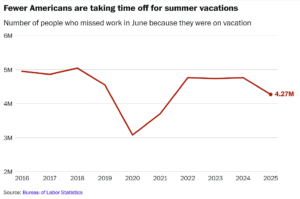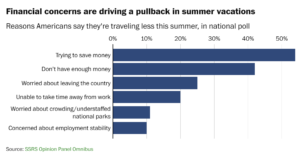Hawaii; Living in the Trump Economy
In a one-two economic punch, Hawaii’s economy been negatively impacted by Trump administration policies and reactive-actions on Federal workers based in the state, and by extension their economic contribution to the state. Official numbers for federal worker firings in Hawaii this year (as of July 30, 2025) are scarce and conflicting. However, several reports and lawsuits indicate that numerous federal workers in Hawaii were affected by firings or layoffs earlier this year, impacting jobs and the economic contribution they represent to the state’s economy.
At the same time, high prices and economic jitters are leading the traveling public to pull back on domestic vacation plans in what experts call a move to the “staycation season”.
Hawaii’s highly tourist-dependent economy is not immune in this shift and the potential loss of visitor spending in the state. The pullback in visitors follows months of economic warning signs. Americans say they are feeling worse about the economy than they have in years, as new and disruptive trade and immigration policies take hold nationally. Many are bracing for a spike in prices from new tariffs, while others are worried about losing their jobs in a slowing labor market.
 Americans are downsizing their summer vacations — taking shorter trips, driving instead of flying, and generally staying closer to home in an uncertain economy. This recent pull back in leisure travel is one several economic side effects of the current administration’s chaotic management of national priorities, from rollercoaster tariffs to all other things economic
Americans are downsizing their summer vacations — taking shorter trips, driving instead of flying, and generally staying closer to home in an uncertain economy. This recent pull back in leisure travel is one several economic side effects of the current administration’s chaotic management of national priorities, from rollercoaster tariffs to all other things economic
Families appear to be pulling back on travel spending after years of splurging on vacations and other experiences after pandemic-era shutdowns. Fewer households are booking airline tickets or hotel rooms now than they were a year ago, as Bank of America data shows. And the number of people taking vacation time off work in June dropped to its lowest level since the pandemic, according to Labor Department data.
The Trump administration’s national tariff chaos continues to swing from on to off and back again with renewed tariff threats as recently as this week — including rates as high as 50 percent on goods from Brazil, Japan and Canada starting Aug. 1 — altogether fueling fears that a new round of inflation may be around the corner coupled to higher consumer prices.
- Consumer spending dropped in May, as households put more of their incomes in savings in anticipation of higher costs.
- Credit card balances, at $1.2 trillion, are near an all-time high, and delinquency rates are rising on mortgages and student loans as more Americans fall behind on everyday expenses.
Years of inflation, coupled with rising health care, insurance and utility costs, have pinched household budgets.
 Airline Travel Outlook
Airline Travel Outlook
Southwest Airlines, American Airlines and JetBlue have all warned that slowing domestic demand could weigh on profits this year.
Alaska Airlines and Hawaiian Airlines, combined, will operate over 40,000 flights annually with more than 8.5 million seats to Hawaii, making them the largest domestic carrier to the islands. In September 2023 alone, there were about 600,000 total passengers (525,000 in economy) from the Continental US to Hawaii, according to Cirium.
Most Americans (representing the bulk Hawaii visitors) — 56 percent — say they plan to travel less this summer, according to a national poll by SSRS. Many said they were opting for shorter or “more budget-conscious” trips because of financial concerns, with 54 percent saying they would be trying to save more money this year in face increasing economic uncertainties and rising costs.
Breaking News; August 1st
Dow drops 500 points, S&P 500, Nasdaq slide after weak jobs report, Trump’s tariff redux
President Donald Trump has signed an executive order imposing tariffs ranging from 10% to 41% on imports from dozens of trade partners in his latest attempt to reshape the global economy. The new rates, which Trump sees as benefiting US exporters, unleash a fresh round of uncertainty for dozens of countries, including longtime US allies. It has also raised fears of inflation in the US.
Rates were set at 25% for India’s US-bound exports, 20% for Taiwan and 30% for South Africa. Switzerland faces a rate of 39%. The deadline for a tariff deal with Mexico was extended by another 90 days. Brazil’s tariff rate was set at 10%, but a previous order signed by Trump placed a 40% tariff on some Brazilian goods, to punish the country for prosecuting its former president, Jair Bolsonaro, for trying to overturn an election he lost and inspiring his supporters to storm the seat of government. Separately, the White House announced that Canadian imports will face tariffs of 35%, not the current 25%. The order stated that Canada had “failed to cooperate”.
Trump said in a disconnect from the facts, that the new tariffs were going “very well, very smooth.” In an interview with NBC News he added that it was “too late” for the countries named in Thursday’s order to avoid the tariff rates, but that he was open to offers.



The damning irony is that Biden overcame the previous malpractice with some moves foundational to a truly thriving and more equitable economy. Trump has made all the absolutely wrong moves, as if (?) deliberately tanking prospects for a decent economy, preferring an oligarchy presiding over wasted assets and subsisting — temporarily — on financial chicanery.
It’s really hard to know how a revived economy could begin, once the chaff are out of office. I would count on millions of smart, energetic, and creative souls to make it come around, assuming that new leadership could emerge to take on the complex jobs of de-constructing the financialized portions, while enacting deep changes to financial regulations, to the eternal dismay of the wayward oligarchs and their misled minions, all shouting down reform with more feudal lies.
It’s difficult to envision pursuing two otherwise apparently opposing strategies — curbing financialization and democratizing corporations, while investing in widely-distributed foundational research into regenerative agriculture, energy innovation, health research, and broadly distributed manufacturing, democratizing AI, and providing universal healthcare and childcare. And still facing off with dinosaur politicians of red states.